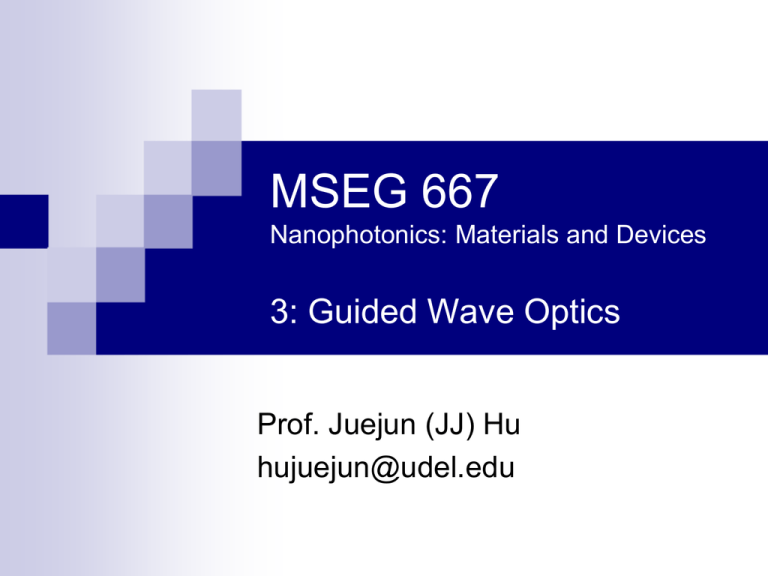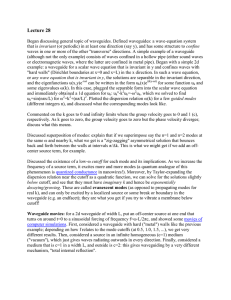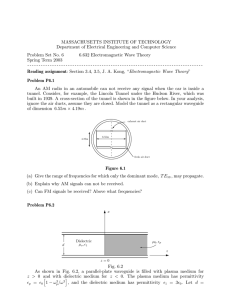MSEG 667 3: Guided Wave Optics Prof. Juejun (JJ) Hu
advertisement

MSEG 667 Nanophotonics: Materials and Devices 3: Guided Wave Optics Prof. Juejun (JJ) Hu hujuejun@udel.edu Modes “When asked, many well-trained scientists and engineers will say that they understand what a mode is, but will be unable to define the idea of modes and will also be unable to remember where they learned the idea!” Quantum Mechanics for Scientists and Engineers David A. B. Miller Guided wave optics vs. multi-layers Light Longitudinal variation of refractive indices Refractive indices vary along the light propagation direction Approach: transfer matrix method Devices: DBRs, ARCs Transverse variation of refractive indices The index distribution is not a function of z (light propagation direction) Approach: guided wave optics Devices: fibers, planar waveguides H L H L H L High-index substrate Why is guided wave optics important? It is the very basis of numerous photonic devices Optical fibers, waveguides, traveling wave resonators, surface plasmon polariton waveguides, waveguide modulators… Fiber optics The masters of light “If we were to unravel all of the glass fibers that wind around the globe, we would get a single thread over one billion kilometers long – which is enough to encircle the globe more than 25 000 times – and is increasing by thousands of kilometers every hour.” -- 2009 Nobel Prize in Physics Press Release Waveguide geometries and terminologies 2-d optical confinement 1-d optical confinement cladding nlow core nhigh cladding nlow Slab waveguide core nlow nhigh cladding Channel/photonic wire waveguide cladding core Step-index fiber Graded-index (GRIN) fiber nlow nhigh nlow Rib/ridge waveguide How does light propagate in a waveguide? light Question: If we send light down a channel waveguide, what are we going to see at the waveguide output facet? ? JJ knows the answer, but we don’t ! A B C D E What is a waveguide mode? A propagation mode of a waveguide at a given wavelength is a stable shape in which the wave propagates. Waves in the form of such a mode of a given waveguide retain exactly the same cross-sectional shape (complex amplitude) as they move down the waveguide. Waveguide mode profiles are wavelength dependent Waveguide modes at any given wavelength are completely determined by the crosssectional geometry and refractive index profile of the waveguide Reading: Definition of Modes 1-d optical confinement: slab waveguide 2 n2 2 Wave equation: 2 2 E 0 c0 t with spatially non-uniform refractive index Ey x, z, t U x ei z eit x y TE: E-field parallel to substrate z Helmholtz equation: 2 / z d2 [ 2 k 2 2 ]U ( x ) 0 dx k = nk0 = nω/c Propagation constant is related to the wavelength (spatial periodicity) of light propagating in the waveguide effective index Propagation constant: β = neff k0 Field boundary conditions Quantum mechanics = ? Guided wave optics … The similarity between physical equations allows physicists to gain understandings in fields besides their own area of expertise… -- R. P. Feynman Quantum mechanics "According to the experiment, grad students exist in a state of both productivity and unproductivity." -- Ph.D. Comics Guided wave optics Quantum mechanics = ? Guided wave optics … The similarity between physical equations allows physicists to gain understandings in fields besides their own area of expertise… -- R. P. Feynman Quantum mechanics 1-d time-independent Schrödinger equation 2 2 [ x V E ] ( x ) 0 2m ψ(x) : time-independent wave function (time x-section) -V(x) : potential energy landscape -E : energy (eigenvalue) Time-dependent wave function (energy eigenstate) ( x, t ) ( x ) exp( iEt ) t : time evolution Guided wave optics Helmholtz equation in a slab waveguide [2x k02n 2 2 ]U ( x ) 0 U(x) : x-sectional optical mode profile (complex amplitude) k02n(x)2 : x-sectional index profile β2 : propagation constant Electric field along z direction (waveguide mode) E ( x, z ) U ( x ) exp( iz ) z : wave propagation 1-d optical confinement problem re-examined Helmholtz equation: Schrödinger equation: [2x k02n 2 2 ]U ( x ) 0 x [ V nclad ncore 1 2 x V E ] ( x ) 0 2m ? V0 nclad nclad ncore n • Discretized propagation constant β values • Higher order mode with smaller β have more nodes (U = 0) • Larger waveguides with higher index contrast supports more modes • Guided modes: nclad < neff < ncore E3 E2 Vwell E1 x 1-d potential well (particle in a well) • Discretized energy levels (states) • Wave functions with higher energy have more nodes (ψ = 0) • Deeper and wider potential wells gives more bounded states • Bounded states: Vwell < E < V0 Waveguide dispersion waveguide dispersion short λ high ω long λ low ω β = neff k0 = neff ω/c0 nclad ncore nclad ncoreω/c0 ncladω/c0 At long wavelength, effective index is small (QM analogy: reduced potential well depth) At short wavelength, effective index is large Group velocity in waveguides ncoreω/c0 Low vg ncladω/c0 vg d d Group index ng Phase velocity vp: traveling speed of any given phase of the wave Group velocity vg: velocity of wave packets (information) c0 d c0 vg d neff c0 c0 vp Effective index: spatial periodicity (phase) Waveguide effective index is always smaller than core index Group index: information velocity (wave packet) In waveguides, group index can be greater than core index! 2-d confinement & effective index method Channel waveguide Rib/ridge waveguide nclad nclad ncore ncore nclad Directly solving 2-d Helmholtz equation for U(x,y) Deconvoluting the 2-d equation into two 1-d problems Separation of variables Solve for U’(x) & U”(y) U(x,y) ~ U’(x) U”(y) nclad neff,core nclad y z x neff,clad neff,core neff,clad Less accurate for highindex-contrast waveguide systems EIM mode solver: http://wwwhome.math.utwente.nl/~hammerm/eims.html http://wwwhome.math.utwente.nl/~hammer/eimsinout.html Coupled waveguides and supermode V x Anti-symmetric WG 1 WG 2 Symmetric x Cladding x Modal overlap! supermodes neff + Δn neff - Δn http://wwwhome.math.utwente.nl/~ hammer/Wmm_Manual/cmt.html Coupled mode theory Symmetric ≈ (U 1 U 2 ) exp[ ikz ( neff n )] Anti-symmetric + U1 ≈ (U1 U 2 ) exp[ ikz ( neff n )] U2 + U1 U 2 U 2 exp( i ) If equal amplitude of symmetric and antisymmetric modes are launched, coupled mode: (U1 U 2 ) exp[ ikz (neff )] (U1 U 2 ) exp[ ikz (neff )] z=0 2U1 z = π/2kΔn z = π/kΔn 2U2 exp(iπ/2Δn) 2U1 exp(iπ/Δn) 1 2 z π/kΔn Beating length Waveguide directional coupler Symmetric coupler Asymmetric waveguide directional coupler Optical power Optical power Beating length π/kβ Propagation distance Propagation distance 3dB direction coupler WG 1 WG 2 Cladding 10 log 10 (0.5) ~ 3.0(dB) Optical loss in waveguides Material attenuation Roughness scattering Electronic absorption (band-to-band transition) Bond vibrational (phonon) absorption Impurity absorption Semiconductors: free carrier absorption (FCA) Glasses: Rayleigh scattering, Urbach band tail states Planar waveguides: line edge roughness due to imperfect lithography and pattern transfer Fibers: frozen-in surface capillary waves Optical leakage Bending loss Substrate leakage Waveguide confinement factor Consider the following scenario: A waveguide consists of an absorptive core with an absorption coefficient acore and an nonabsorptive cladding. How do the mode profile evolve when it propagate along the guide? core cladding E E x, y exp i r z it exp a wg z Modal attenuation coefficient: a wg corea core x Propagation ncore c0 0 E dxdy 2 Confinement core factor: core Re E H * z dxdy E ? J. Robinson, K. Preston, O. Painter, M. Lipson, "First-principle derivation of gain in high-index-contrast waveguides," Opt. Express 16, 16659 (2008). x Absorption in silica (glass) and silicon (semiconductor) Short wavelength edge: Rayleigh scattering (density fluctuation in glasses) Long wavelength edge: Si-O bond phonon absorption Other mechanisms: impurities, band tail states Short wavelength edge: band-to-band transition Long wavelength edge: Si-Si phonon absorption Other mechanisms: FCA, oxygen impurities (the arrows below) Roughness scattering Origin of roughness: Planar waveguides: line edge roughness evolution in processing T. Barwicz and H. Smith, “Evolution of line-edge roughness during fabrication of highindex-contrast microphotonic devices,” J. Vac. Sci. Technol. B 21, 2892-2896 (2003). Fibers: frozen-in capillary waves due to energy equi-partition P. Roberts et al., “Ultimate low loss of hollow-core photonic crystal fibres,” Opt. Express 13, 236-244 (2005). QM analogy: time-dependent perturbation Modeling of scattering loss High-index-contrast waveguides suffer from high scattering loss F. Payne and J. Lacey, “A theoretical analysis of scattering loss from planar optical waveguides,” Opt. Quantum Electron. 26, 977 (1994). T. Barwicz et al., “Three-dimensional analysis of scattering losses due to sidewall roughness in microphotonic waveguides,” J. Lightwave Technol. 23, 2719 (2005). a wg , s ncore 2 nclad 2 2 where is the RMS roughness Optical leakage loss n x Single-crystal Silicon Silicon oxide cladding nSi nSiO2 Silicon substrate x QM analogy V x Tunneling! Unfortunately quantum tunneling does not work for cars! Boundary conditions Guided wave optics Quantum mechanics • Continuity of wave function • Continuity of the first order derivative of wave function Polarization dependent! Core y Cladding Substrate x z TE mode: Ez = 0 (slab), Ex >> Ey (channel) TM mode: Hz = 0 (slab), Ey >> Ex (channel) Boundary conditions Guided wave optics TE mode profile Polarization dependent! Core y Cladding Substrate x z TE mode: Ez = 0 (slab), Ex >> Ey (channel) TM mode: Hz = 0 (slab), Ey >> Ex (channel) Ex amplitude of TE mode y y x z x Discontinuity of field due to boundary condition! Slot waveguides Field concentration in low index material y slot x z Cladding Substrate TE mode profile Use low index material for: • Light emission • Light modulation • Plasmonic waveguiding V. Almeida et al., “Guiding and confining light in void nanostructure,” Opt. Lett. 29, 1209-1211 (2004).






